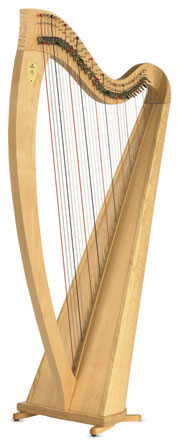
Today in Mrs. S’s class I brought in a small lever harp. Seeing it in it’s black zipper case, the children wondered what it was. Some children knew. “How did you know?” I asked. “Because of it’s shape!” a little girl volunteered. It is fun to see what music children have been exposed to in their young lives.
We began class singing the DM theme song, and then we sang our Solfa scale “up and down the mountain” (an ascending and descending scale, beginning with middle C as Do). I sang slowly, as they had just begun learning the hand signs two weeks before. I took one girl and one boy volunteer to perform in front of the class. If a child does a sign wrong, I sometimes take the time to correct it–just in a little way to help them learn it. For example, if their fists are up high, I’ll say encouragingly, “Move your fists down by your belly button. Good job!” Or if “Ti” is difficult, I say, “Make some glasses in front of your eyes with your hands. Now POP the first finger up! And then move your hands back out in front of you. That’s right!”
After our scale, I reminded the children how we talked about each note having it’s own name and it’s own voice, just like each of them have their own unique voices, like we talked about last week. Some notes are higher and some are lower. I picked two notes (starting with “Daddy Do” and “Baby Do”) and asked which sound was higher and which one was lower. Daddy Do! I pointed out that “Daddy Do” is taller than “Baby Do” and showed them this by pulling the individual bells out and standing them up next to each other in front of me for the children to see.
I told them that each note sings its voice and we hear different notes because of the vibrations. (One little girl reminded us that “sound is vibrations that travel through the air to your ear that sends a message to your brain.” (I am always amazed at how much young children can remember even with such few repetitions and so much time elapsing in between lessons.) I explained that vibrations can travel at different speeds. “What is speed?” I asked. I ran fast across the front of my teaching space, and ran back the other way. Then I walked slowly back and forth. We talked about fast and slow. I asked them if they had ever seen a speed limit sign (I forgot my visual of one). It shows how fast you can drive your car down a road. “Do you ever say to your Dad or Mom, “Dad! You’re driving too fast!” (I always like getting the children to smile.) We tell cars how many miles per hour they can drive. We can also tell how fast or slow vibrations are going, and that is what gives them their PITCH. I had them repeat that word two or three more times. Pitch is how fast or slow the vibrations are going per second. Middle C (“Daddy Do”) is 256 Hertz, or oscillations per second. So there are 256 sound waves passing by in one second. Wow! That’s fast! Some pitches are a lot slower, like 80 Hertz, or a lot faster, like 440 Hertz. Symphonies tune to A at 440 Hz or above (A above middle C).
I took the cover off of the harp and pulled it to the front. As some of the strings were out of tune, I got out the tuner and started to tune them. One of the children guessed that the red strings were Do (C), and she was right! I showed them how each of the red strings had the same pitch, except that some were lower and some were higher. I meant to show them that the longer strings had the lower pitches and the shorter strings had higher pitches, but I think I might have forgotten that! (You can ask your child.)
I showed them a glissando going up the harp from low to high and going down from high to low. I told them that harpists do not use their pinkies to play the strings–only their thumbs through fourth fingers. I had them all come up and play a glissando on the harp. Then they sat back down and watched “Chanson dans la nuit” (French for Song in the Night) by Carlos Salzedo and played by Yolanda Kondonassis (video here). I told them that the song was describing sounds that you might hear at night, such as wind. I asked them what they hear at night. They answered crickets, ants, birds, trees, dear (“reindeer”), bears. So we listened and they loved it. “Can we watch it again?” one little boy asked. I wished! We were out of time, and we sang our goodbye song.
(Glissandos begin at 3:00. Lots of technique talk until then.)
Tip: If you don’t own a harp (what are the chances?!) or know someone who does, you can Google “Suzuki harp teachers” or “harp teachers locally” or “wedding harpist” and see what comes up! Or check with your local university to see if there is a harp teacher in your area. Inviting teachers or students to come demonstrate their instruments can be good advertising for them and good exposure for your students! (Plus, you don’t have to haul it around!) It is always so beneficial for the students to get to see and touch different instruments, because it influences them on future choices of what they might learn to play later.